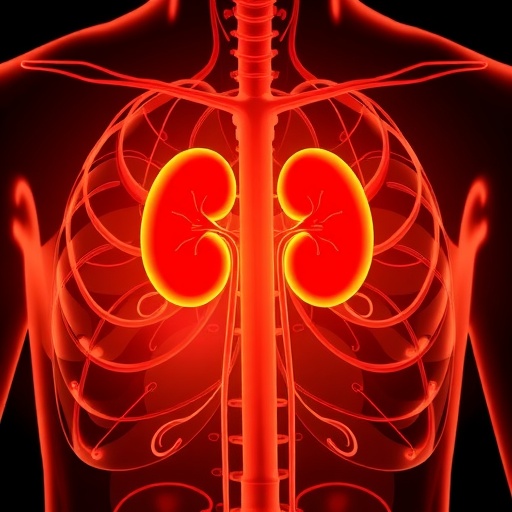Houston, TX (November 8, 2025) — In a groundbreaking advancement poised to reshape kidney transplant protocols, recent research highlights the limitations of the current kidney transplant waitlisting criterion, which relies solely on a single estimate of kidney function measured by the estimated glomerular filtration rate (eGFR ≤ 20 ml/min/1.73m²). This outdated approach fails to account for the complex individual risk profiles that dictate the progression toward kidney failure. An innovative study underscores the potential of incorporating the Kidney Failure Risk Equation (KFRE), a multifactorial tool that estimates a patient’s two-year risk of progression to kidney failure, to enhance waitlist decision-making. This paradigm shift is anticipated to optimize patient outcomes and address long-standing racial disparities in access to kidney transplantation, findings scheduled for presentation at ASN Kidney Week 2025, held November 5–9 in Houston, TX.
The Kidney Failure Risk Equation (KFRE) integrates critical variables such as age, sex, eGFR, and urine albumin concentration to generate a personalized risk estimate for kidney failure within the ensuing two years. Unlike the rigid eGFR threshold currently used, the KFRE captures the dynamic interplay of metabolic, demographic, and clinical elements influencing disease trajectory. Analyzing data from 10,368 US veterans with chronic kidney disease (CKD) in 2022, researchers discovered that 60% met both the existing eGFR criterion and the KFRE-derived risk threshold of ≥25% for progression, while 20% met only one criterion exclusively. This divergence elucidates significant heterogeneity in disease severity and progression risk among patients deemed eligible under current guidelines.
Demographic analysis revealed striking differences between patient cohorts selected by the traditional eGFR criterion versus the KFRE risk threshold. Veterans meeting only the eGFR ≤20 ml/min/1.73m² criterion tended to be older, averaging 71 years, whereas those qualifying solely based on KFRE ≥25% risk were significantly younger, with a mean age of 53 years. Moreover, the KFRE-focused group included a higher proportion of males and individuals from minority racial and ethnic backgrounds, encompassing Hispanic, Black, and Asian populations. These patients also displayed increased prevalence of diabetes and albuminuria, markers often associated with accelerated kidney decline. This demographic shift points toward a more inclusive and precise allocation strategy that aligns transplantation eligibility with nuanced risk profiles rather than static biochemical cutoffs.
Longitudinal examination of patient outcomes between 2006 and 2019 further accentuated the clinical utility of KFRE-based risk stratification. Participants who met both traditional and KFRE criteria, as well as those meeting the KFRE threshold alone, demonstrated higher incidences of progressing to end-stage kidney disease (ESKD). Intriguingly, these groups exhibited lower overall mortality compared with individuals qualifying only by eGFR ≤20 ml/min/1.73m², implying that younger patients with high progression risk experience greater kidney-related morbidity but potentially better survival. This evidence challenges the current waitlisting paradigm that may inadvertently disadvantage younger, at-risk populations by neglecting individualized risk assessment.
The implications of this study resonate beyond patient selection for waitlisting, ushering in an era of personalized medicine in nephrology. By embedding the KFRE into clinical algorithms, nephrologists and transplant teams can prioritize candidates who are both imminently at risk of kidney failure and likely to benefit most from preemptive transplantation. Such tailored risk assessment could mitigate waitlist mortality, reduce time-to-transplant, and ultimately improve long-term graft survival by intervening earlier in the disease cascade.
Critically, the adoption of KFRE-based criteria also holds promise in addressing entrenched disparities in kidney transplantation access. Historically, minority populations experience disproportionate progression to ESKD and face systemic barriers in transplantation pathways. The KFRE’s inclusion of demographic and clinical factors facilitates equitable identification of high-risk individuals across racial and ethnic groups, promoting more just allocation and opening avenues for targeted interventions geared toward vulnerable groups. This approach aligns with broader health equity goals in nephrology and transplant medicine.
Jennifer L. Bragg-Gresham, MS, PhD, lead author and researcher at the University of Michigan Medical School, emphasizes the transformative potential of integrating individualized risk prediction into kidney transplant criteria. “Expanding the waitlisting criteria to include risk of kidney failure prioritizes patient-centered care, offering a tailored approach that improves outcomes for younger patients with chronic kidney disease and ameliorates racial disparities in transplantation access,” she states. Dr. Bragg-Gresham underscores the necessity for prospective validation of the KFRE-guided listing strategy across diverse patient populations, including those beyond the veteran cohort, to ensure broad applicability and optimize clinical impact.
The technical underpinnings of the KFRE leverage robust statistical modeling and longitudinal cohort data to quantify the two-year risk of progression to kidney failure, taking into account critical biomarkers like urine albumin-to-creatinine ratio and eGFR, along with demographic covariables. This multivariate risk score outperforms simplistic threshold-based approaches by capturing the complex pathophysiology governing renal decline. The KFRE’s predictive precision has been corroborated in multiple international cohorts, rendering it a valuable adjunct for clinical decision-making specifically in transplant eligibility and timing.
Implementation of this risk-based paradigm necessitates integration into electronic health records and transplant center workflows, enabling timely clinician access to patient-specific risk metrics at point of care. Furthermore, education of healthcare providers regarding the interpretation and utility of KFRE scores is imperative to foster adoption and standardize transplant listing practices nationally. The study advocates for ongoing research to refine cutoffs, evaluate cost-effectiveness, and explore patient outcomes linked to KFRE-guided transplantation strategies.
The significance of this research lies in its potential to recalibrate kidney transplant eligibility, shifting from a rigid eGFR-centric framework to a nuanced, patient-oriented risk stratification model. This evolution could shorten waiting times for those most at risk, improve transplant success rates, and diminish racial and age-related biases currently evident within kidney transplantation systems. As the nephrology community gathers at ASN Kidney Week 2025, these findings propel forward an exciting discourse on precision nephrology and equitable organ allocation.
ASN Kidney Week 2025, convening in Houston, is the premier event for cutting-edge nephrology research and clinical advancements. With global experts and 12,000 attendees, this annual meeting offers a timely platform to disseminate and debate the implications of integrating KFRE into kidney transplant policy. The conference environment fosters interdisciplinary dialogue aimed at translating this evidence into clinical practice innovations that will ultimately elevate patient care standards worldwide.
As the fight against chronic kidney disease intensifies, the application of innovative risk assessment tools such as the Kidney Failure Risk Equation heralds a new horizon. Aligning transplant waitlisting protocols with individualized disease progression probabilities offers a transformative leap toward personalized nephrology care, promising not only improved survival and quality of life for patients but also strides toward equity in organ transplantation.
Subject of Research: Optimizing Kidney Transplant Waitlisting Criteria through Risk Prediction
Article Title: Incorporating the Kidney Failure Risk Equation to Transform Kidney Transplant Eligibility and Address Racial Disparities
News Publication Date: November 8, 2025
Web References: http://www.asn-online.org/
Keywords: Kidney disease, kidney transplantation, Kidney Failure Risk Equation, eGFR, chronic kidney disease, risk stratification, organ allocation, health disparities, personalized medicine
Tags: ASN Kidney Week 2025chronic kidney disease researcheGFR limitations in kidney failureinnovative healthcare protocolsKidney Failure Risk Equationkidney function estimation methodskidney transplant waitlisting strategymultifactorial risk assessment toolspatient outcome optimizationpersonalized medicine in nephrologyprogression to kidney failure risk factorsracial disparities in kidney transplantation





